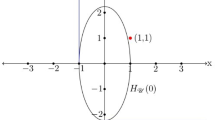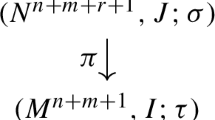Abstract
This paper addresses the robust stabilization problem of Boolean control networks with disturbance inputs (DBCNs) via the semi-tensor product (STP) of matrices, and designs all feasible state feedback stabilizers. Based on the algebraic form of DBCNs, some necessary and sufficient conditions are derived for the robust stabilization of DBCNs by Ledley antecedence solution technique. An algorithm is proposed to determine all complete families of robust reachable sets, moreover, all feasible state feedback stabilizers are obtained. Finally, two numerical examples are exploited to illustrate the effectiveness of the proposed results as well as the controller design scheme.
Similar content being viewed by others
References
S. A. Kauffman, “Metabolic stability and epigenesis in randomly constructed genetic nets,” Journal of Theoretical Biology, vol. 22, no. 3, pp. 437–467, 1969.
I. Shmulevich, E. R. Dougherty, and W. Zhang, “From Boolean to probabilistic Boolean networks as models of genetic regulatory networks,” Proceedings of the IEEE, vol. 90, no. 11, pp. 1778–1792, 2002.
L. Wang, E. E. Pichler, and J. Ross, “Oscillations and chaos in neural networks: An exactly solvable model.,” Proceedings of the National Academy of Sciences, vol. 87, no. 23, pp. 9467–9471, 1990.
J. Heidel, J. Maloney, C. Farrow, and J. Rogers, “Finding cycles in synchronous Boolean networks with applications to biochemical systems,” International Journal of Bifurcation and Chaos, vol. 13, no. 3, pp. 535–552, 2003.
D. Cheng, H. Qi, and Z. Li, Analysis and Control of Boolean Networks, Springer-Verlag, London, 2011.
H. Li, Y. Liu, S. Wang, and B. Niu, “State feedback stabilization of large-scale logical control networks via network aggregation,” IEEE Transactions on Automatic Control, vol. 66, no. 12, pp. 6033–6040, 2021.
J. Lu, L. Sun, Y. Liu, D. W. Ho, and J. Cao, “Stabilization of Boolean control networks under aperiodic sampled-data control,” SIAM Journal on Control and Optimization, vol. 56, no. 6, pp. 4385–4404, 2018.
X. Zhang, Y. Wang, and D. Cheng, “Output tracking of Boolean control networks,” IEEE Transactions on Automatic Control, vol. 65, no. 6, pp. 2730–2735, 2019.
A. Yerudkar, C. del Vecchio, and L. Glielmo, “Output tracking control design of switched Boolean control networks,” IEEE Control Systems Letters, vol. 4, no. 2, pp. 355–360, 2019.
Y. Chen, P. Sun, T. Sun, M. O. Alassafi, and A. M. Ahmad, “Optimal output tracking of switched Boolean networks,” Asian Journal of Control, vol. 24, no. 3, pp. 1235–1246, 2022.
D. Cheng, “Disturbance decoupling of Boolean control networks,” IEEE Transactions on Automatic Control, vol. 56, no. 1, pp. 2–10, 2010.
S. Fu, J. Zhao, and J. Wang, “Input-output decoupling control design for switched Boolean control networks,” Journal of the Franklin Institute, vol. 355, no. 17, pp. 8576–8596, 2018.
Y. Liu, L. Tong, J. Lou, J. Lu, and J. Cao, “Sampled-data control for the synchronization of Boolean control networks,” IEEE transactions on cybernetics, vol. 49, no. 2, pp. 726–732, 2018.
M. Meng and J. Feng, “Optimal control problem of singular Boolean control networks,” International Journal of Control, Automation and Systems, vol. 13, no. 2, pp. 266–273, 2015.
S. Fu, D. Cheng, J.-e. Feng, and J. Zhao, “Matrix expression of finite Boolean-type algebras,” Applied Mathematics and Computation, vol. 395, p. 125880, 2021.
F. Liu, Y. Cui, J. Wang, and D. Ji, “Observability of probabilistic Boolean multiplex networks,” Asian Journal of Control, vol. 23, no. 3, pp. 1583–1590, 2021.
Y. Sun, G. Feng, and J. Cao, “Robust stochastic stability analysis of genetic regulatory networks with disturbance attenuation,” Neurocomputing, vol. 79, pp. 39–49, 2012.
H. Li and Y. Wang, “Robust stability and stabilisation of Boolean networks with disturbance inputs,” International Journal of Systems Science, vol. 48, no. 4, pp. 750–756, 2017.
J. Zhong, D. W. Ho, J. Lu, and W. Xu, “Global robust stability and stabilization of Boolean network with disturbances,” Automatica, vol. 84, pp. 142–148, 2017.
E. Fornasini and M. E. Valcher, “Recent developments in Boolean networks control,” Journal of Control and Decision, vol. 3, no. 1, pp. 1–18, 2016.
H. Li and Y. Wang, “Further results on feedback stabilization control design of Boolean control networks,” Automatica, vol. 83, pp. 303–308, 2017.
A. Yerudkar, C. Del Vecchio, and L. Glielmo, “Feedback stabilization control design for switched Boolean control networks,” Automatica, vol. 116, p. 108934, 2020.
S. Zhu, J. Lu, Y. Liu, T. Huang, and J. Kurths, “Output tracking of probabilistic Boolean networks by output feedback control,” Information Sciences, vol. 483, pp. 96–105, 2019.
R. S. Ledley, “Digital computational methods in symbolic logic, with examples in biochemistry,” Proceedings of the National Academy of Sciences of the United States of America, vol. 41, no. 7, pp. 498–511, 1955.
Y. Jia, D. Cheng, and J. Feng, “State feedback stabilization of generic logic systems via Ledley antecedence solution,” Mathematical Methods in the Applied Sciences, pp. 1–11, 2021. DOI: https://doi.org/10.1002/mma.7554.
Y. Wang and P. Guo, “Optimal control of singular Boolean control networks via Ledley solution method,” Journal of the Franklin Institute, vol. 358, no. 12, pp. 6161–6173, 2021.
J. Wang, R. De Leone, S. Fu, J. Xia, and L. Qiao, “Stabilisation and set stabilisation of periodic switched Boolean control networks,” International Journal of Control, pp. 1–12, 2021.
Y. Wang and H. Li, “Output trackability of Boolean control networks via Ledley antecedence solution,” IEEE Transactions on Circuits and Systems II: Express Briefs, vol. 69, no. 3, pp. 1183–1187, 2021.
A. Veliz-Cuba and B. Stigler, “Boolean models can explain bistability in the lac operon,” Journal of Computational Biology, vol. 18, no. 6, pp. 783–794, 2011.
H. Li, L. Xie, and Y. Wang, “On robust control invariance of Boolean control networks,” Automatica, vol. 68, pp. 392–396, 2016.
Author information
Authors and Affiliations
Corresponding author
Ethics declarations
We certify that there is no conflict of interest/competing interests in relation to this article.
Additional information
Publisher’s Note Springer Nature remains neutral with regard to jurisdictional claims in published maps and institutional affiliations.
This work is supported by the National Natural Science Foundation of China under grants 62103176, and the Natural Science Foundation of Shandong Province under grant ZR2019BF023.
Xinling Li received her Ph.D. degree from the School of Mathematical Science, University of Electronic Science and Technology of China, Chengdu, China, in 2020. She is currently with the School of Mathematical Science, Liaocheng University, Liaocheng, China. Her research interests include Boolean networks, game theory, and logical dynamic systems.
Shihua Fu received her Ph.D. degree from the School of Control Science and Engineering, Shandong University, Shandong, China, in 2018. Since 2018, she is a teacher with the School of Mathematical Sciences, Liaocheng University, Liaocheng, China. Her research interests include semi-tensor product of matrices, and its application in networked evolutionary games and logical networks.
Jianjun Wang received his B.S. and M.S. degrees from the School of Mathematical Sciences, Liaocheng University, Liaocheng, China, in 2015 and 2018, respectively. He received a Ph.D. degree from the School of Science and Technology, University of Camerino, Camerino, Italy, in 2022. His research interests include game theory and application, and logical dynamic systems.
Rights and permissions
About this article
Cite this article
Li, X., Fu, S. & Wang, J. Ledley Solution Method for All Feasible State Feedback Stabilizers of Boolean Control Networks With Disturbances. Int. J. Control Autom. Syst. 22, 84–92 (2024). https://doi.org/10.1007/s12555-022-0590-x
Received:
Revised:
Accepted:
Published:
Issue Date:
DOI: https://doi.org/10.1007/s12555-022-0590-x




